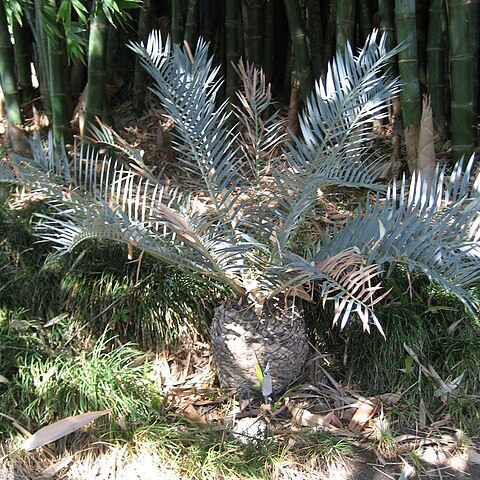Plant branched from the base or sometimes unbranched, with stems up to about 1 m tall and 25-30 cm diam. Leaves usually glaucous-green when young, becoming green with age, 0.75-1.25 m long including petiole 15-22 cm long, glabrous; rhachis stiff usually recurved and often twisted towards apex, with dirty white collar round tomentose pulvinus; leaflets spaced and reduced in size towards base, occasionally overlapping in upper half; median leaflets linear-lanceolate, or oblong-lanceolate, often somewhat falcate, 10-18 cm long, 1.5-2.5 cm broad, pungent with terminal spine up to 6 mm long, usually with 1-2 pungent lobes 1-3 cm long from lower margin. Cones solitary, general colour blue-green or yellowish-green, shortly and stoutly pedunculate. Male cones subcylindric, narrowed to both ends, 25-35 cm long, 6.5-7.5 cm diam.; median scales about 2.5 cm long, 2.5-2.8 cm broad with sharp lateral angles; bulla face projected into a beak 7 mm long, terminal facet about 6 mm broad and 6 mm wide vertically. Female cones broadly subcylindric, rounded or narrowed to apex, 40-50 cm long and 16-18 cm diam.; median scales 7-9 cm long, 6-7 cm broad and 3.5-4 cm thick vertically, with lateral ridges extending into the incurved lateral lobes 2-3 cm long; bulla face protruding 2.5-3 cm, sparsely hairy with adpressed whitish hairs, upper facet with rugose ridges converging on the terminal facet and with irregular pointed papillae round the base, lower facet rounded, terminal facet smooth or sparsely grooved, concave, about 1 cm broad and 1 cm wide vertically. Seeds reddish to yellowish-orange, 4-5 cm long and 2 cm diam., with fleshy beak (there is likely to be greater variability in cone size than recorded here based on limited material).
More
Plant dioecious, palm-like. Stem aerial or decumbent, 0.5-2.0 m tall, unbranched or branched from base, covered by alternating series of woody bracts and persistent, swollen, truncated leaf bases. Leaves petiolate, pinnate with rachis recurved; terminal leaflets (at least lobed, pungent-pointed, margins not markedly thickened; reduced in size towards base of rachis. Cones Feb.-Oct., 1 or 2, appear sessile, yellowish green. Male cones oblanceoloid. Female cones cylindric to ovoid, broader than male, facets verrucose.


